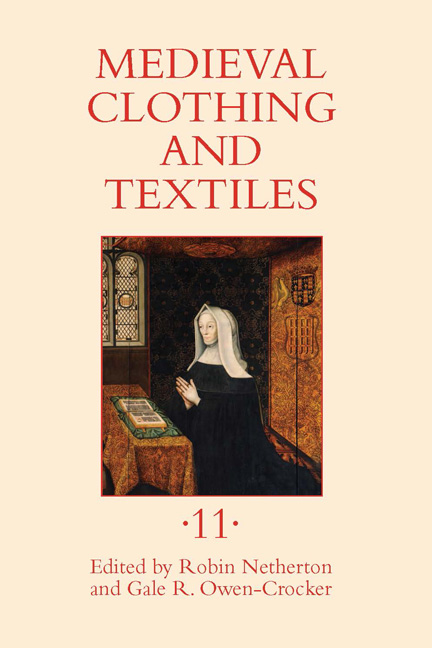Book contents
- Frontmatter
- Contents
- Illustrations
- Tables
- Contributors
- Preface
- 1 Production, Quality, and Social Status in Viking Age Dress: Three Cases from Western Norway
- 2 The Effect of Spindle Whorl Design on Wool Thread Production: A Practical Experiment Based on Examples from Eighth-Century Denmark
- 3 The Shirt Attributed to St. Louis
- 4 Angevin-Sicilian Sumptuary Statutes of the 1290s: Fashion in the Thirteenth-Century Mediterranean
- 5 The Devil on My Tail: Clothing and Visual Culture in the Camposanto Last Judgment
- 6 “Transposing þe shapus þat God first mad them of”: Manipulated Masculinity in the Galaunt Tradition
- 7 Textiles and Dress in the Household Papers of Lady Margaret Beaufort (1443–1509), Mother of King Henry VII
- 8 “Like two artificial gods”: Needlework and Female Bonding in A Midsummer Night's Dream
- Recent Books of Interest
- Contents of Previous Volumes
2 - The Effect of Spindle Whorl Design on Wool Thread Production: A Practical Experiment Based on Examples from Eighth-Century Denmark
Published online by Cambridge University Press: 05 December 2015
- Frontmatter
- Contents
- Illustrations
- Tables
- Contributors
- Preface
- 1 Production, Quality, and Social Status in Viking Age Dress: Three Cases from Western Norway
- 2 The Effect of Spindle Whorl Design on Wool Thread Production: A Practical Experiment Based on Examples from Eighth-Century Denmark
- 3 The Shirt Attributed to St. Louis
- 4 Angevin-Sicilian Sumptuary Statutes of the 1290s: Fashion in the Thirteenth-Century Mediterranean
- 5 The Devil on My Tail: Clothing and Visual Culture in the Camposanto Last Judgment
- 6 “Transposing þe shapus þat God first mad them of”: Manipulated Masculinity in the Galaunt Tradition
- 7 Textiles and Dress in the Household Papers of Lady Margaret Beaufort (1443–1509), Mother of King Henry VII
- 8 “Like two artificial gods”: Needlework and Female Bonding in A Midsummer Night's Dream
- Recent Books of Interest
- Contents of Previous Volumes
Summary
The drop spindle is a tool that has been used to facilitate thread production for many thousands of years. It has two key components: a central shaft and a stabilizing weight called a whorl. Before spinning, prepared fibers are usually arranged on a stick called a distaff, which enables the person doing the spinning to carry a large amount of fiber and keep it from becoming tangled. To turn the fiber into thread, the spinner attaches a leading end of the fiber to the spindle shaft, and then, with a flick of the fingers, sets the spindle in motion. As the spindle rotates, twisting the attached fiber into thread, the spinner gently pulls additional fiber from the distaff and directs it toward the spindle at a regular pace, an action called drafting. The thread elongates as the twist travels up the incoming supply of fiber. Gravity keeps the thread taut. When the spindle reaches the ground, the spinner winds the finished thread around the shaft and begins the process again.
While the basic principle of the drop spindle has remained the same, the design of the tool has changed over time and location. In particular, not only has the material and size of the whorl varied from one time and place to another, the whorl shape has shown dramatic changes as well. The series of experiments described in this article represent an effort to determine what impact, if any, changes in whorl design have on the qualities of the thread produced. The study was designed to shed light on why a spinner might prefer one kind of spindle over another; to consider whether changes in spindle design were the result of desired outcome or personal preferences; to identify the attributes of spindles that make them well suited to their task; and to establish whether a particular type of whorl can be identified with the manufacture of a particular cloth.
- Type
- Chapter
- Information
- Medieval Clothing and Textiles 11 , pp. 29 - 48Publisher: Boydell & BrewerPrint publication year: 2015



